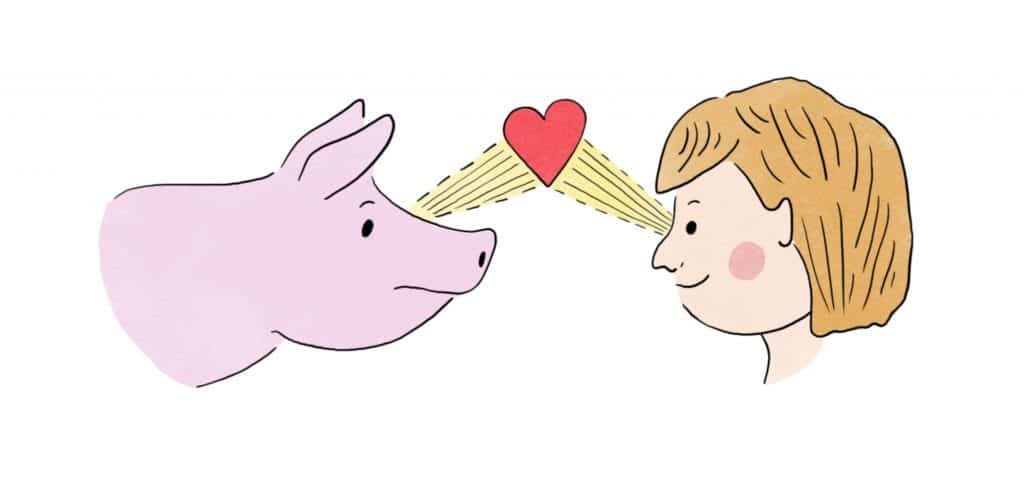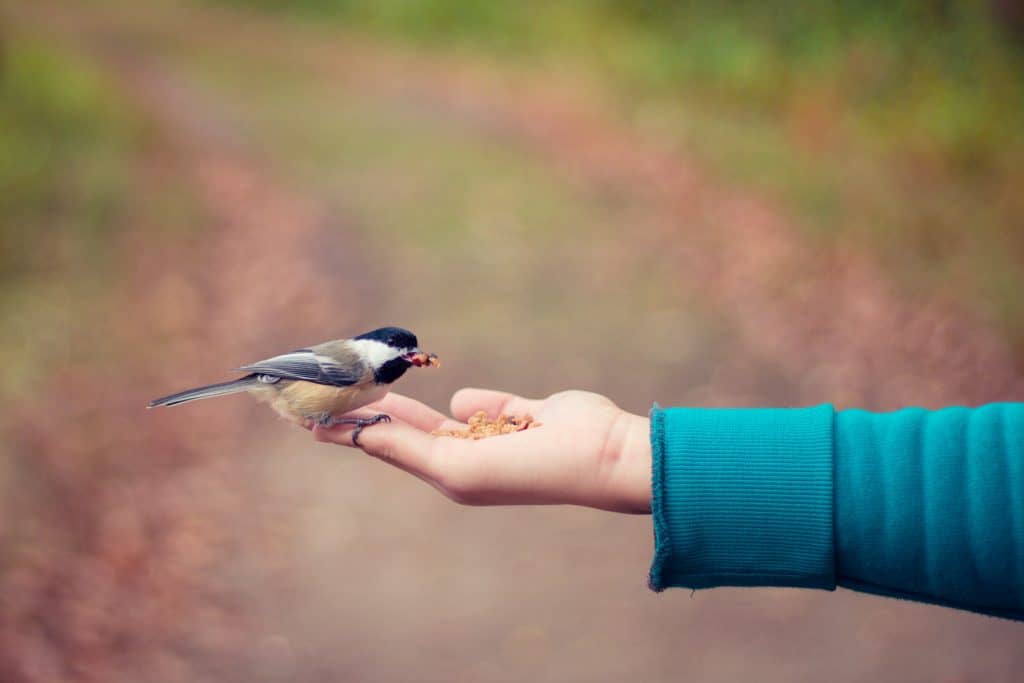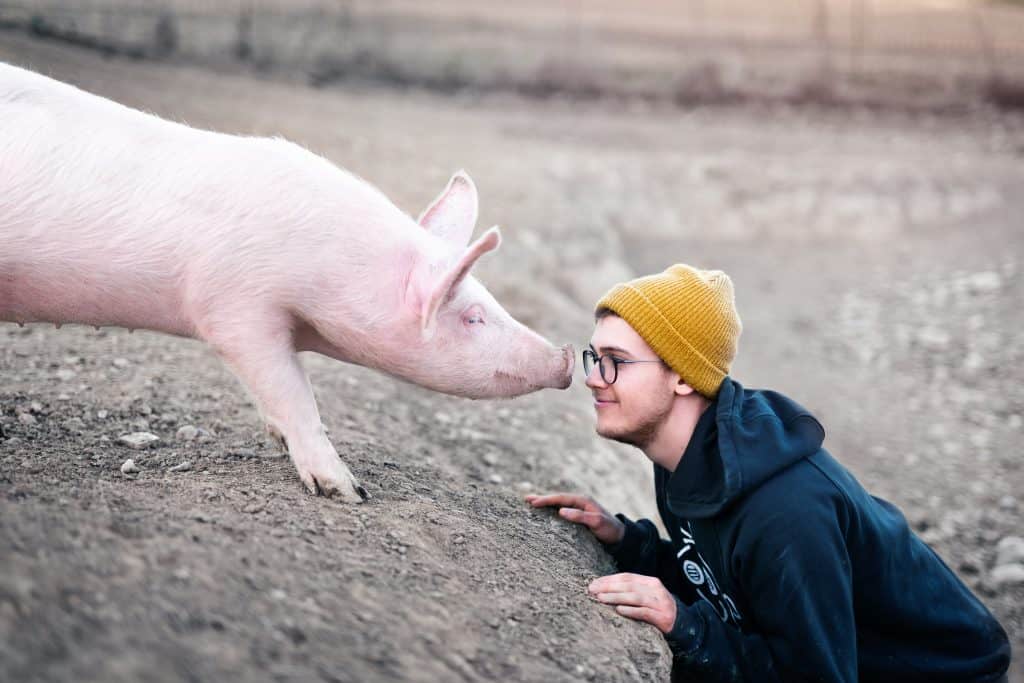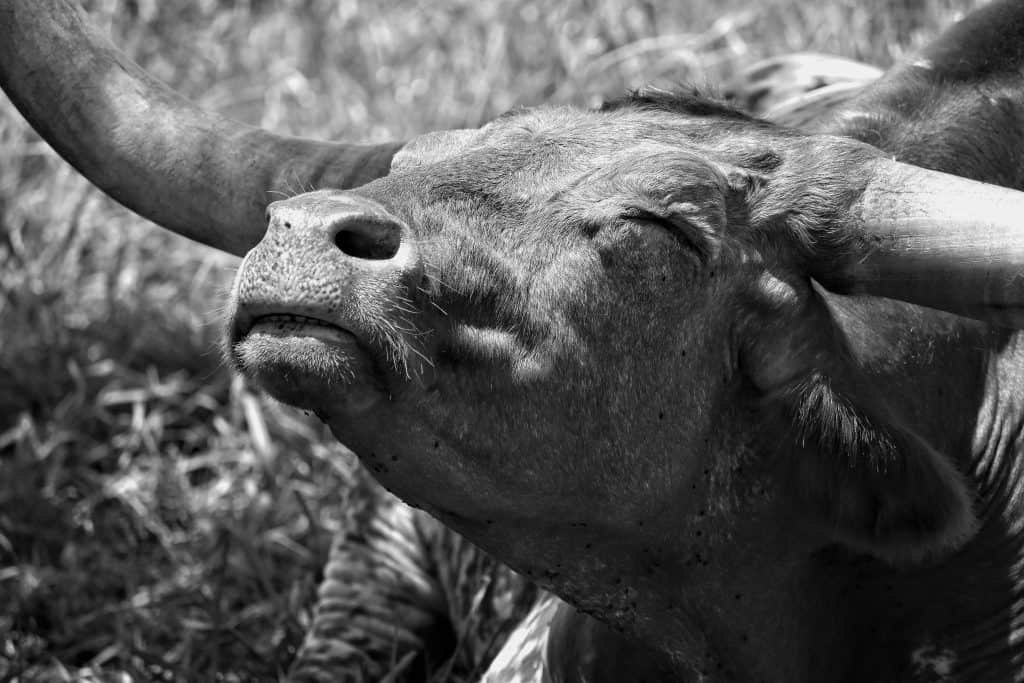
Introduction
Developing empathy is a complex process that is facilitated by age, language, behavior, social norms, and life experience. When we look at how to foster empathy in people who visit animal sanctuaries, we need to consider the various genetic and social components of empathy that can nurture and impede this process. The purpose of this article is to provide sanctuaries with information on what empathy is (and isn’t), why it matters, how it develops, as well as some of the contributing factors and barriers to fostering empathy towards farmed animalsA species or specific breed of animal that is raised by humans for the use of their bodies or what comes from their bodies..
What Is Empathy?

Empathy IS:
The ability to put oneself in the place of another and try to understand how the world looks to that other, not from one’s own perspective, but from the perspective of the individual going through it. (Lori Gruen, Entangled Empathy)
Subcategories Of Empathy
Empathy can be subcategorized into three abilities:
Emotional/affective empathy: the ability to sense or “experience” the perceived emotions of another, almost as if we were experiencing the same feeling. This is thought to be made possible by mirror neurons: nerve cells in our brains that fire up when we watch and listen to someone else, allowing us to feel some similar emotions.
Cognitive empathy: the ability to understand the experiences of another by imagining ourselves in their reality. This is a learned skill that can mature over time through the development of theory of mindTheory of mind is the ability to distinguish between your own mind and that of others., accurate knowledge about another’s experience, and perspective-taking exercises.
Empathic concern/compassion: the feeling that arises when you are made aware of another’s suffering and feel motivated to take action and relieve that suffering. Empathic concern/compassion is sometimes referred to as “empathy in action”.
Empathy Is NOT:
Sympathy: recognizing the plight of another and feeling sorry or pity for them. Sympathy may or may not consist of real understanding of the other’s experience and it may or may not lead to action.
Projection: attributing one’s own emotions and state of mind onto someone else. When we project, we make assumptions about another’s experience that may or may not be true for them.
Why Empathy Matters

Empathy is an essential building block of social connection and prosocial behavior – behavior intended to help others. Many individual studies have been done on empathy and its relation to the well-being of animals. Research has shown that developing empathy for animals results in behavioral and attitudinal changes that can include abstention from eating them. In short, the more we develop empathy for animals, the more likely we are to protect them.
How Empathy Develops

Humans are genetically inclined to develop and practice empathy toward those with whom they are connected and have close relationships. Like other emotional and mental capabilities, empathy varies by age and brain development. Here is how empathy develops by age:
Infancy – Pre-Kindergarten
At this age, young children see animals as anthropomorphic peers and think and behave as if animals feel just like them. They struggle to recognize realities and perspectives that differ from their own.
Kindergarten – Early Elementary
At this age, children are naturally inclined to form very close relationships with animals. They can read animal behavior and interpret meaning from them. They also understand that animals can choose with whom they want to interact, so being chosen by an animal can create and greatly strengthen child-animal bonds. At this stage, however, children continue to project their own anthropomorphic wants and desires onto animals.
Early Elementary – Adulthood
During this time, children develop the ability to understand diverse perspectives that differ from their own. They can see animals as unique others with similarities and differences. This ability continues to expand into adulthood as they practice their understandings of relationships with others and social norms.
A Note On Brain Development
As we age, our brains constantly reorganize to make sense of new experiences, connections, and understandings of the world. As these connections and understandings are reinforced through our social environment, interactions, and life experiences, they become stronger and more challenging to change. In other words, the older the brain, the more difficult it is to change or build new ways of thinking. Takeaway: If you are teaching empathy toward farmed animals with adults, it is easier to change their ways of thinking and behavioral patterns slowly over time than try to change them quickly. If you are teaching empathy toward farmed animals with children, it is easier to change their ways of thinking and behavioral patterns more quickly.
In addition to being a genetic process that is affected by age and brain development, empathy is also an emotional and mental skill that can be taught and nurtured over time through life experience and practice. In supportive social and educational environments, empathy requires a person to be present, focused, and reflective. Researchers have found that if people are asked to take time to consider and reflect on the perspective of a nonhuman animal, they are more likely to express empathic concern for them and invest in ways to protect that animal.
Our capacity to empathize can also be hindered by life experience and unsupportive social environments. When we look at how to foster empathy in animal sanctuary visitors, we must consider the various social environments and cultural contexts from which they could be coming.
Barriers To Developing Empathy

Before we dive into the various research-supported practices that help foster empathy for farmed animals, let’s explore some of the factors that can hinder the development of empathy for animals.
Barrier: Evolutionary Distance To Humans
Nonhuman animals have differing abilities to elicit empathy in humans. Research has shown that empathy towards a nonhuman animal gradually decreases with their evolutionary distance to humans. In other words, humans prefer animals who look, think, and act more like humans. So, larger more human-like beings tend to attract more empathy from humans than beings that are small and less human-like. As a result, humans tend to care more about the life of mammals like orangutans than the life of birds like chickens.
Barrier: Negative Emotional States
Creating negative emotional states by showing and using distressing images, videos, and rhetoric can be influential when it comes to developing empathy towards nonhuman animals. However, eliciting too much negative emotion for too long can also have the unintended consequence of hindering empathy development. When people are in a negative emotional state for too long, their brains can erect an emotional barrier that protects them from continuing in this state. This is called moral disengagement and usually entails people removing personal responsibility from distressing events, disregarding the events as out of their control, and sometimes blaming the victims. Takeaway: while animal exploitationExploitation is characterized by the abuse of a position of physical, psychological, emotional, social, or economic vulnerability to obtain agreement from someone (e.g., humans and nonhuman animals) or something (e.g, land and water) that is unable to reasonably refuse an offer or demand. It is also characterized by excessive self gain at the expense of something or someone else’s labor, well-being, and/or existence. is an urgent and important issue, be mindful of the rhetoric and graphic images you use in your educational spaces. Sometimes the louder you yell, the less people hear you.
Barrier: Anthropomorphism
Anthropomorphism is a naturally occurring human process of projection. It occurs when we (mis)attribute human experiences, characteristics, emotions, needs, and desires onto nonhuman animals in an effort to understand them better. However, nonhumans do not experience the world in the same ways we do and projecting our own understandings onto them can lead to inaccurate and harmful conclusions about their experiences, perspectives, and needs. Sometimes, it manifests in actions like: rescuing animals that don’t need to be rescued, creating a false sense of closeness with potentially dangerous or uninterested animals, projecting negative human stereotypes onto animals, and having certain social expectations that animals cannot meet.
From Challenge To Opportunity
While anthropomorphism can hinder one’s ability to correctly empathize with an animal, it can also help people develop empathy for them if it’s used thoughtfully. When applied in certain circumstances (especially with younger children) where animal experiences are actually similar to human experiences, it can inspire deeper consideration of animals and a desire to protect them. Takeaway: if you are applying anthropomorphism as a point of entry into conversations about empathy towards farmed animals, make sure you highlight true similarities between human and animal lived realities, perspectives, characteristics, and needs. Make sure you highlight our differences, too! We can never truly know what it’s like to be a nonhuman animal, but we can interpret what it’s like with a varying degree of accuracy based on factual species-specific knowledge and relationship building.
Barrier: Cultural Stigmas
There are a lot of false harmful cultural narratives that inaccurately stigmatize some nonhuman animals (e.g. roosters are aggressive, pigs are filthy, turkeysUnless explicitly mentioned, we are referring to domesticated turkey breeds, not wild turkeys, who may have unique needs not covered by this resource. are unintelligent, etc.). Usually, harmful cultural stigmas and biases occur as a result of a lack of accurate species-specific knowledge and experience that is replaced with fear. And fear blocks empathy!
Barrier: Environmental
Research has shown when we remove animals from their more natural living environments and prohibit them from participating in their natural behaviors, we reduce the ability to elicit empathy towards them.
Overcoming these barriers to empathy can be challenging, but it’s not impossible. So, let’s take a closer look at some of the ways we can effectively foster empathy towards farmed animals.
Contributing Factors To Fostering Empathy Towards Farmed Animals

Sanctuary spaces offer animal advocates unique opportunities to spark and nurture people’s empathy for animals. But how do sanctuaries effectively guide visitors to understand, recognize, and empathize with the experiences and needs of animals? How do you provide information and experiences that encourage prosocial behavior and compassionate action that benefit the well-being of nonhuman animals?
Model Empathetic Behavior
As a skill, empathy can be built through modeling and dialogue. So, how you interact with your residents and your visitors matters. It’s important to physically model the empathetic behaviors you want your visitors to develop. Visitors, especially children, pay close attention to how adults behave and notice when their actions don’t align with their message. Research has shown that adults with strong environmental morals credit childhood role models as the most influential factor with regards to their love of the environment**. Therefore, it’s important to be mindful of the way you handle, move, and transport your residents. How you talk about those actions also makes a difference. It’s helpful to explain what you’re doing and why you’re doing it so you don’t unintentionally reinforce something potentially harmful. By modeling the empathetic behavior you want your visitors to develop, you can help encourage more nurturing relationships with farmed animals.
Modeling isn’t exclusively about direct actions. Carefully consider the messages on your clothing, signs, walls, fences, gates, etc. and ensure that they also align with your desire to nurture empathy.
**Role Models
Research has shown that building long-term relationships is an important factor when it comes to role model status. Although there is often very little time to develop long-term relationships with sanctuary visitors, it might be helpful to try to design educational programming that could encourage this.
Narrative (Re)Framing
How you talk to and about your residents also affects the development of empathy towards them. As aforementioned, there are a lot of harmful cultural narratives, phrases, and words out there that stigmatize and hinder empathy towards farmed animals. One way you can help foster empathy is by re-framing those narratives! Re-framing can include:
- Replace the pronoun “it” when referring to residents with their names and pronouns he/she and they. “It” supports objectification and commodification. Using resident names and pronouns like he/she and they acknowledges them as subjective others or living beings who experience the world from their own unique perspective.
- Shift harmful cultural narratives based in fear with narratives based in accurate species-specific knowledge. Empathy for farmed animals increases the more people correctly understand their needs, behaviors, and lived realities. You can help facilitate this by sharing all the accurate and wonderful qualities of your residents. Explain their place at the sanctuary and their relationship to their wild relatives. It’s also helpful to share some of the false harmful narratives and point out the misinformation and inaccuracies in them. Invite visitors to point out misrepresentations they’ve heard of, too, especially as they observe, hear, interact with, and learn about your residents’ personalities and experiences.
- Help visitors understand that farmed animals are sentient. Contrary to many false narratives, they do have the capacity to feel and perceive.
Build Perspective-Taking
Engaging visitors in experiences that allow them to consider the perspectives of farmed animals is a powerful way to build their capacity to empathize with them. There are many ways you can invite visitors to do this:
- Storytelling: Stories are a wonderful way to illuminate the lived realities, experiences, and perspectives of your sanctuary residents. While you share the stories of how they arrived at sanctuary, it’s helpful to ask and answer empathic questions about residents’ perceived thoughts and feelings as they went through those experiences. How would it feel to be that animal going through that? What do you imagine they felt? Would you have liked to be them? Why or why not? Verbally acknowledging an animal’s experience in conversation can increase visitors’ connections to your residents and spark empathic responses towards other farmed animals as they might personally identify with some of their experiences and feelings. It’s also important to share positive stories of your residents (e.g. what’s their life like in sanctuary? Who are their friends and family members? What do they like to do during the day?, etc.), as well as examples of empathic behaviors and events that had a positive impact on farmed animals. You could also share animal-friendly stories in print or via video that share the unique perspectives of farmed animals, explain their experiences, and encourage compassion towards them.
- Role Play: Considering the perspectives of farmed animals can sometimes be enacted more literally. We can activate our empathy by imaginatively assuming the role of a particular animal in a process called “embodied simulation” or physically moving through another’s experience or perspective. This is a form of empathy that involves kinesthetically taking on the identity of an animal based on direct observation, video footage, guided visualizations, or species-specific knowledge, and then acting or interacting with others or the environment as that animal. It activates our mirror neurons and helps us better understand the motor intentions and perceptions of an animal simply by moving like they do! Some sanctuaries incorporate this type of role-play for negative animal experiences such as crowding several people inside a tiny space to help them understand what it might be like as a hen trapped inside a battery cage. However, this exercise is also incredibly powerful when we have people simulate positive animal experiences. This could be mimicking a cowWhile "cow" can be defined to refer exclusively to female cattle, at The Open Sanctuary Project we refer to domesticated cattle of all ages and sexes as "cows." walking in the grass, wagging their tail, and feeling a light breeze on their face or a bunny running around in the grass doing binkies in the air! Either way, role play and embodied simulation can help sanctuary visitors engage in perspective-taking and imagine the feelings and emotions of farmed animals. Research has shown that perspective-taking activities are at the core of empathy development and much more impactful than simply showing images.
Observation And Interaction
Many individual studies have shown that people, particularly children, who have more frequent interactions with animals develop more connection to them. And connection is one of the seeds of empathy. This is one reason why so many animal sanctuaries have on-site tour programs. They can invite visitors to observe, get to know, interact with, and celebrate farmed animals. However, it’s important to first determine whether on-site tours are feasible for your sanctuary and if so, establish and maintain appropriate emotional and physical safety measures for your residents and visitors. Research has also shown that animals who are allowed the autonomyThe ability for individuals to have access to free movement, appropriate food, and the ability to reasonably avoid situations they wish to avoid. to show agency (e.g. move the way they want to, including moving away from and towards the visitors of their choosing) and behave naturally without human intervention or handling, elicit more empathy in visitors. The more time people responsibly spend with farmed animals, the more likely they are to build deep connections and relationships based on familiarity and shared experiences.
Service-Learning Opportunities And Practice
In addition to spending more time with animals, sanctuaries can invite their visitors to go a step further and practice their empathy for farmed animals by participating in service-learning opportunities that help them. Service-learning can include opportunities to care for farmed animals (e.g. cleaning their housing structures and living spaces, feeding them, giving them water, brushing them, etc.). If your sanctuary is able to responsibly implement projects like this, it’s helpful to provide positive feedback to your participants and acknowledge their empathic actions, statements, and questions. This encourages their belief in their ability to empathize and work towards building an identity as an empathic person.
Service-learning opportunities can also include learning events like workshops, where visitors can listen to folks directly involved with farmed animalA species or specific breed of animal that is raised by humans for the use of their bodies or what comes from their bodies. care and advocacy, learn new skills, engage in dialogue, and develop creative ways to help farmed animals.
Nurture Self-Empathy And Give People Time To Reflect
Learning about animal exploitation is challenging and can sometimes lead to moral disengagement, compassion fatigue, stress, and burnout. Studies show that taking care of ourselves and practicing self-empathy is linked to our ability to more accurately understand and empathize with the emotions and experiences of others, which is why it’s so important to model this kind of behavior for your visitors as well. This can be as simple as letting folks verbalize their emotions and allowing them to process how they feel as they go through your educational programming. Reflective exercises can also encourage your visitors to identify the connections between their own emotions and experiences with those of farmed animals.

Sources:
Entangled Empathy | Lori Gruen
Entangled Empathy and Eco-Feminism | Earthling Liberation Kollective
Best Practices in Developing Empathy Towards Wildlife | Informal Science
The Emerging Study of Positive Empathy | North American Association for Environmental Education
Theory of Mind: The Root of Empathy | Exploring Your Mind
The Role of Empathy Toward Animals in Meat Avoidance | Faunalytics








